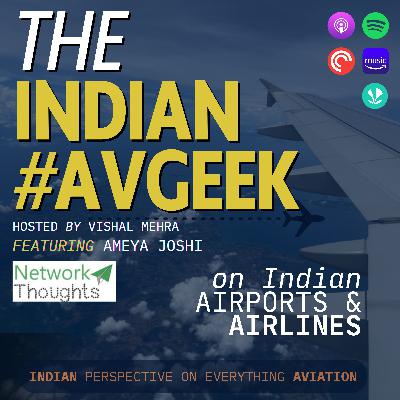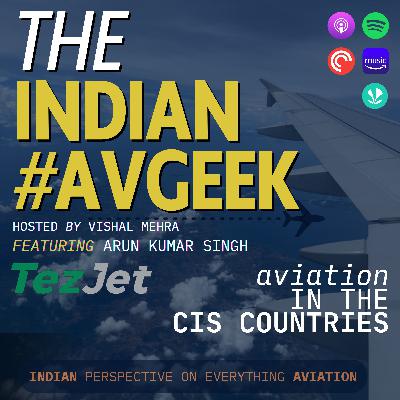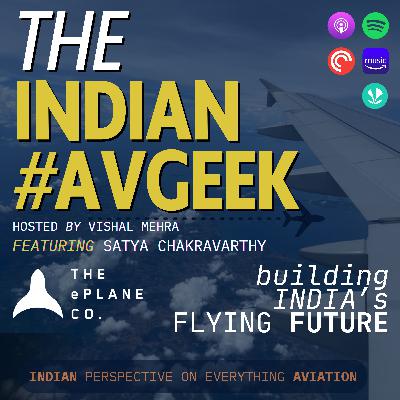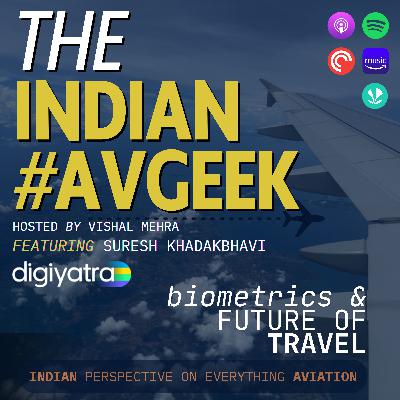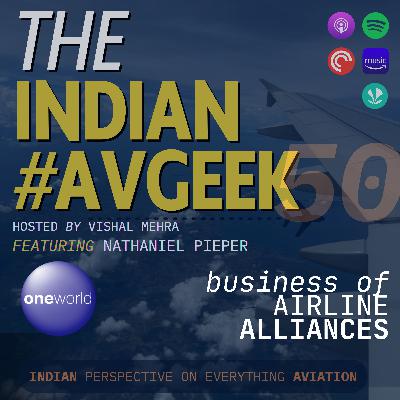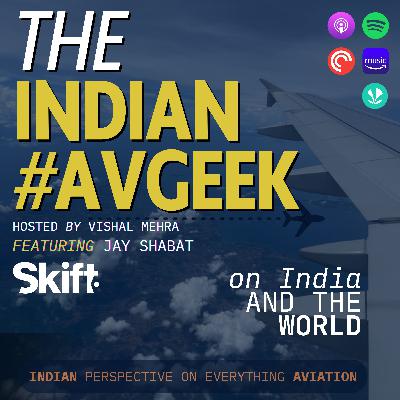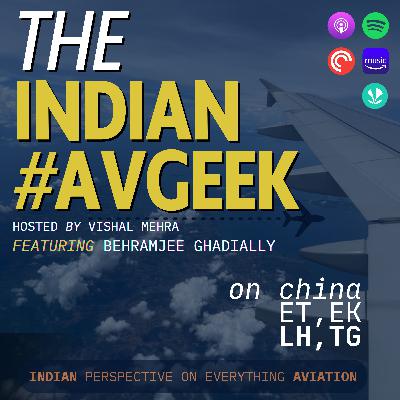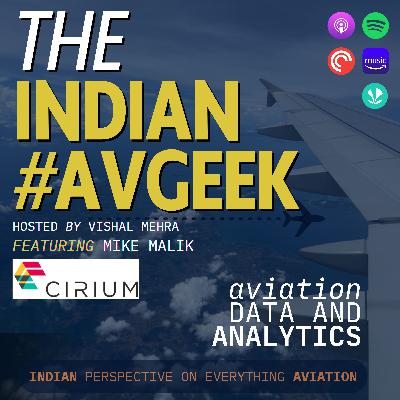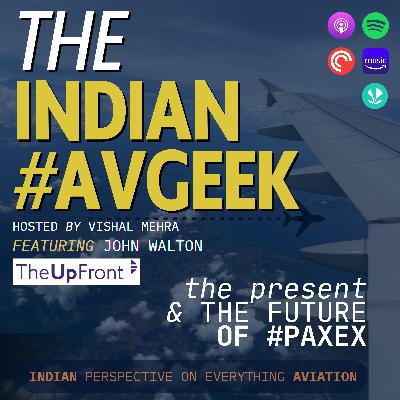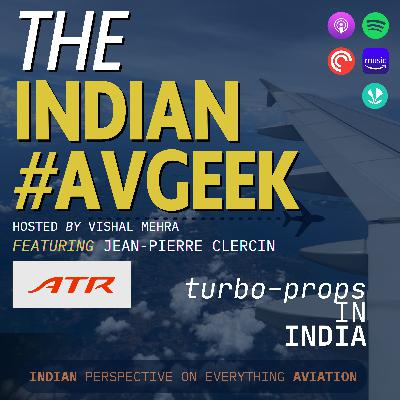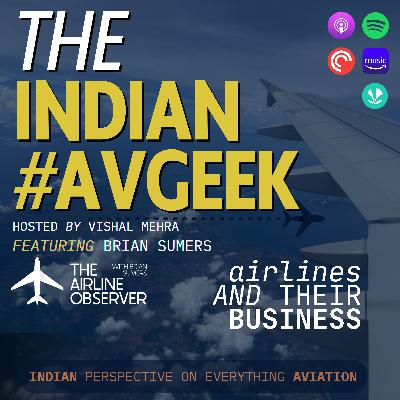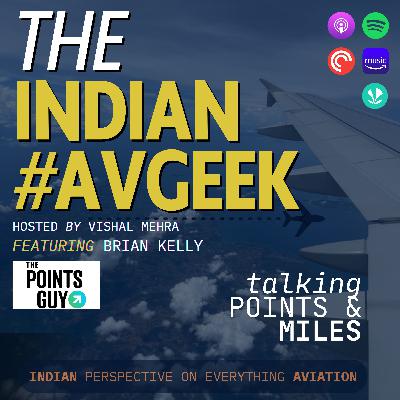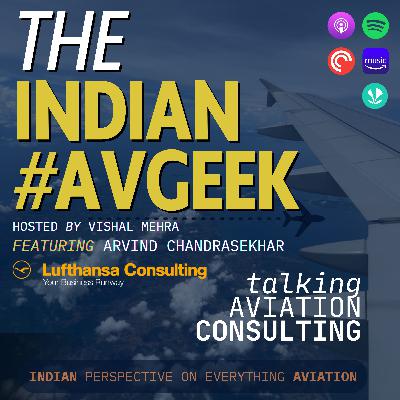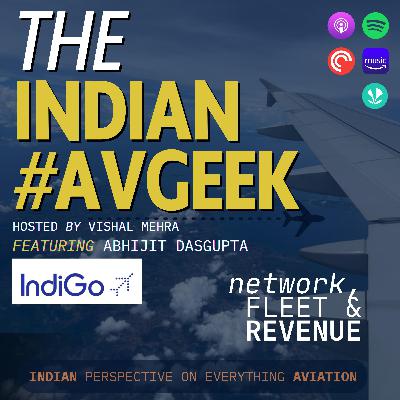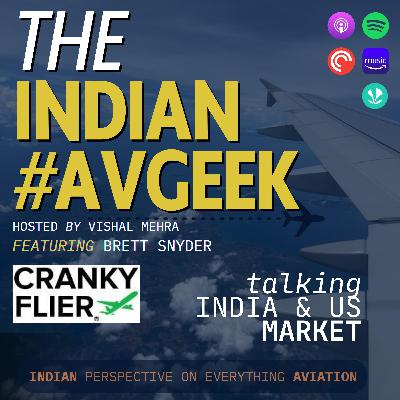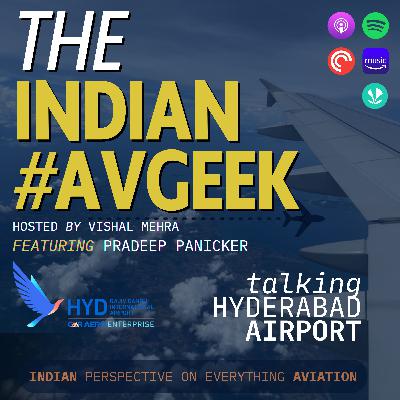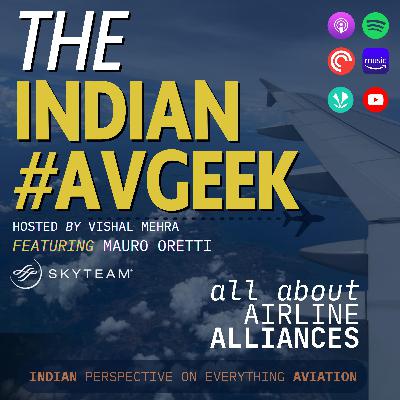Discover The Indian AvGeek
The Indian AvGeek

The Indian AvGeek
Author: Vishal Mehra
Subscribed: 7Played: 98Subscribe
Share
Description
India's number one aviation podcast.
Sharing perspectives on everything related to Indian aviation, from the business of flying to #PaxEx, industry voices, news, and deeper analysis. Every fortnight we cover airlines, airports, OEMs, and the industry at large.
Sharing perspectives on everything related to Indian aviation, from the business of flying to #PaxEx, industry voices, news, and deeper analysis. Every fortnight we cover airlines, airports, OEMs, and the industry at large.
56 Episodes
Reverse
In this episode of The Indian AvGeek, we welcome Ameya Joshi, Founder of NetworkThoughts.com to unpack Delhi Airport’s rise as a global transfer hub, explore underserved corridors, and chart India’s changing network dynamics. From terminal revamps and new mega-hubs to airline slot wars and bold contrarian forecasts, Ameya lays out the strategic moves that will define the next decade of Indian aviation.
✈️ In this discussion, we explore Delhi Airport’s remarkable transformation into a global transit hub, with international-to-international transfers surging 244%. This impressive growth positions Delhi as the best directly connected airport to North America and Europe in South and Southeast Asia.
✈️ Our conversation covers Delhi’s strategic positioning on the East-West corridor, particularly highlighting the success of the Central Asia-Southeast Asia route, where IndiGo’s connections between Bangkok, Phuket and Central Asian cities like Almaty, Tashkent, Tbilisi, and Baku alone drove a 500% increase in transit traffic. We discuss what Delhi Airport needs to become more competitive globally, including infrastructure improvements to Terminal 3 and the potential game-changing impact of an inter-terminal train system.
✈️ The episode delves into Air India’s evolving hub strategy at Delhi, including the recent announcement that 60 of its 180 daily domestic departures will relocate. We examine how this restructuring supports Air India’s European expansion and smaller station connectivity ambitions
✈️ Looking ahead, we discuss the imminent opening of two crucial airports: Noida International Airport (DXN) at Jewar, set to be inaugurated in few weeks, with commercial operations beginning within 45 days and an initial capacity of 12 million passengers annually, and how it might take three years to reach full capacity. We also touch on Navi Mumbai International Airport (NMI), inaugurating this month with the potential to reach its 20 million passenger capacity within the first year of operations
✈️ The discussion turns to India’s evolving airline landscape, where Akasa Air has ascended to become the country’s third-largest carrier. We analyze what it will take for Akasa to solidify its position beyond simply benefiting from SpiceJet’s operational challenges. Speaking of SpiceJet, we examine their puzzling strategy of inducting an Airbus A340 on wet lease, arriving by September-end 2025, potentially for London routes via Gatwick or Stansted
✈️ We explore IndiGo’s strategic partnerships, particularly their collaboration with the SkyTeam alliance carriers including Delta, Air France-KLM, and Virgin Atlantic, positioning them for deeper European and North American connectivity. The episode addresses IndiGo’s upcoming Athens route using India’s first Airbus A321XLR, with six weekly flights split between Delhi and Mumbai starting January 2026. We debate whether the Delhi-Athens market can support both IndiGo and Aegean Airlines’ planned services and discuss the implications for route development.
✈️ Finally, we explore the future of Indian aviation, including the potential for joint venture agreements between Indian and international carriers, the impact of New Distribution Capability (NDC) on revenue management, and bold predictions for India’s aviation landscape over the next 18-24 months. Ameya shares his take on India-Dubai and India-Singapore bilateral capacity, questioning whether relaxed restrictions would truly generate additional demand given current market dynamics.
✈️ Throughout our discussion, we examine how infrastructure constraints, geopolitical factors, and competitive dynamics shape India’s aviation future, while Delhi Airport positions itself among the world’s top five airports within the next decade.
Ameya Joshi - @khabri_lal
Vishal Mehra - @vishal1mehra
Episode 56
Virgin Atlantic isn’t just flying to India; they are painting the skies red with a staggering 350% growth since 2019. In this episode, Vishal sits down with Shivani Singh Deo, Country Manager – India for Virgin Atlantic, to decode how the "cheeky challenger" of aviation is aggressively expanding its footprint in one of the world's largest aviation markets.
Transitioning from a marketing role to leading country operations, Shivani opens up about the strategy behind Virgin’s massive capacity boost—offering one million seats annually on India routes. We deep dive into the mechanics of their four-way partnership with IndiGo, Delta, and Air France-KLM, and how this alliance is reshaping the India-UK-US corridor. We also touch on the recent joint interview of AF-KLM & Lufthansa CEOs on their growing worries about Gulf-based airlines, as well as Turkish Airlines.
Key discussion points:
The 350% Surge: How Virgin Atlantic achieved massive growth and the strategy behind the new Bengaluru and double-daily Mumbai services.Strategic Alliances: Analysing the impact of the IndiGo and SkyTeam partners on Virgin’s competitive edge.Fleet & Product: Why the "youngest, cleanest fleet" matters, and the split between O&D vs. connecting traffic (60:40) to the US.Business of Cargo: Discussing the untold story of a 356% increase in cargo capacity.The Sky High Club: Inside the unique, India-only rewards program for travel agents.Women in Aviation: Shivani’s advice for aspiring female leaders in a male-dominated industry.
Tune in for a masterclass on balancing profitability with personality in the skies.
The Indian AvGeek streams on all major podcast apps.
Vishal Mehra - @vishal1mehra
Episode 55 with Arun Kumar Singh, the CEO of Kyrgyzstan-based TezJet.
From the hyper-regulated regional skies of India’s UDAN scheme to the mountainous terrain of Central Asia, Arun’s journey is as unique as the fleet he operates. With TezJet launching its direct Bishkek-Delhi service this week, we dive deep into the operational reality of connecting India with Kyrgyzstan. But this isn't just a route launch conversation—it is a deep dive into fleet strategy, unit economics, and aviation history.
In this episode, we discuss:
The Return of the Mad Dog: Why TezJet operates the MD-83 (including the last one ever built!) and the Avro RJ85 in an era of A320neos and 737 MAXs.UDAN Reality Check: Having led IndiaOne Air, Arun gives a brutally honest take on why regional connectivity in India cannot survive without subsidies.Kingfisher Untold Stories: Arun shares shocking anecdotes from his time at Kingfisher Airlines, including the story of how Vijay Mallya ordered a fleet of Airbus A340s during a lunch at a London pub—a meal that cost $550 million.Old Jets, New Tech: How TezJet balances flying 28-year-old analog jets while using cutting-edge AI pricing tools like RateGain.Engine Woes: Why Arun is taking Pratt & Whitney’s recovery timeline with a "pinch of salt".
Whether you are an aviation professional tracking CASK and yields or an enthusiast nostalgic for the MD-80 series, this episode is packed with unfiltered insights.
Tune in now!
The Indian AvGeek streams on all major podcast apps.
Arun Kumar Singh - @AKS9955
Vishal Mehra - @vishal1mehra
Episode 54
What happens when a pilot, an airline operator, and a strategist decide to reimagine aviation through the lens of data? In this episode, I sit down with Courtney Miller, the mind behind Visual Approach Analytics, to explore how storytelling, visualisation, and forecasting are reshaping the way airlines make decisions.
What we discussed:
• Courtney’s journey into aviation: from the cockpit to Bombardier and DHL, and eventually into analytics.
• Why he believes the industry was “oddly slow” to recognize the value of aviation analytics.
• Lessons from DHL’s cargo forecasting (yes, Valentine’s Day and Mother’s Day were the most stressful!) and how they differ from passenger airline planning.
• The art of turning complex aviation data into accessible intelligence.
• Fleet planning quirks: Allegiant’s unique approach, Akasa’s Boeing delivery challenges, SpiceJet’s survival instincts, and what Indian carriers like Air India and IndiGo should be doing differently.
• The profitability puzzle: India’s booming demand versus chronic losses—what data signals separate hype from traction.
• Are Indian airlines over-ordering? Courtney breaks down the metrics that reveal overcapacity, underutilization, and systemic risk.
• India’s ambition to be a global hub: should carriers double down on regional connectivity, long-haul expansion, or partnerships?
• Air India’s post-privatization struggles and what it could learn from South Korea’s model of global talent and best practices.
• Disruptive shifts in aviation—from AI and machine learning to evolving fleet strategies—and what’s hype versus reality.
• The next frontier for aviation analytics, misunderstood metrics like load factors and yields, and Courtney’s favorite airline innovation he’d copy worldwide.
Along the way, expect witty detours (including a Ryanair comparison), sharp insights on pricing (“AI doesn’t always mean personalized pricing”), and a candid look at how data has evolved in aviation decision-making over the past five years.
The Indian AvGeek streams on all major podcast apps.
What does it take to reimagine flight for India’s cities — and make it affordable, scalable, and safe? In this episode of The Indian AvGeek, I sit down with Prof. Satya Chakravarthy, Founder, CEO-CTO of The ePlane Company and long-time professor at IIT Madras, to explore how deep-tech innovation is reshaping the skies above us.
From his early fascination with aerospace engineering to his bold leap from academia into ventures like ePlane and Agnikul Cosmos, Prof. Chakravarthy shares the sparks that drive him to tackle frontier problems. We dive into his concept of “defrastructure” — the invisible backbone of future mobility — and how it guides his work across aviation, space, and urban transport.
Together, we unpack:
• 🚁 The design philosophy behind ePlane’s compact eVTOLs and the balancing act of range, payload, and cost
• 🛫 The regulatory gauntlet of securing DGCA’s Design Organisation Approval and lessons learned
• 🔬 The breakthrough of “aerodynamic synergy” in the e200X and why 196+ design iterations were worth it
• 🌆 The roadmap to commercial operations, early customer reactions, and how India’s cities might embrace air taxis
• 🌍 India’s place in the global aerospace race — from UAM to rocketry, and even the possibility of a homegrown civilian airliner
• 💡 Insights from global peers like Joby, Archer, and EHang, and what India can adapt for its own skies
• 👩💻 His advice for young engineers and entrepreneurs daring to build at the edge of science and business
Vishal Mehra - @vishal1mehra
A deep dive into the tech, governance, and everyday friction of modern air travel with the person who helped turn a fringe idea into India’s biometric travel backbone. Suresh Khadakbhavi walks us from a muddy auto ride before his BIAL interview to the pilot with Jet Airways that proved passenger-first biometrics could scale nationally and explains how Digi Yatra is designed to enable seamless journeys without becoming a surveillance system.
What you’ll hear in this episode
• A vivid origin story of how aviation and Suresh found each other, including a memorable muddy-ride interview anecdote that ended with an emergency wardrobe buy.
• The spark inside BIAL’s Innovation Lab that birthed the “walk-through-all-touchpoints-with-no-one-stopping-you” idea and how rapid passenger feedback at BLR turned a developer’s dream into a national program.
• How the 2017 Jet Airways pilot validated core assumptions, which insights convinced stakeholders to scale, and the unexpected operational learnings from working with airlines.
• A clear, technical separation between Digi Yatra’s decentralized self‑sovereign identity model and centralized surveillance systems, plus exactly what data touches external servers during a Digi Yatra transaction.
• The governance and technical design choices made to prevent mission creep and ensure passenger privacy.
• Practical reasons why adoption feels voluntary yet operationally nudged, and how airports balance efficiency with genuine choice.
• Measurable operational wins, including reduced processing times at entry gates and the downstream economics that happier, faster passengers bring to airports and retail.
• The role of partner integrations—airlines, OTAs, and apps—in making Digi Yatra the travel stack for India and the roadmap to gate-level boarding automation.
• International ambitions, collaboration with IATA’s One‑ID work, and the vision for Digi Yatra to interoperate with EU credentials and other global systems for borderless travel.
• Near-term product roadmap highlights: AI-driven multilingual chatbots, anti-spoofing measures, expanded onboarding flows, and pilots beyond airports into hotels and other travel touchpoints.
Vishal Mehra - @vishal1mehra
A milestone episode for The Indian AvGeek. For our fiftieth show we welcome Nathaniel Pieper, an airline lifer who now leads Oneworld. Expect a conversation that blends airline boardroom strategy with the pure joy of flight — fleet tales, alliance chess, lounge plans for India, and the kind of technical nitty gritty only someone who’s ridden the industry for decades can tell.
✈️ How it began — Nat’s first sparks for aviation and the formative moments that steered him from Northwest to a career shaped around alliances and network strategy.
✈️ Alliances as vocation — Why alliances became a repeated thread through his roles at Northwest, Delta, Alaska and now as Oneworld CEO
✈️ Fleet futures — A frank take on the Airbus A321XLR’s ambition to deliver 757-like range and economics and how that shapes network planning
✈️ Lessons learnt from Alaska Airlines — How leading Alaska’s Oneworld entry and previous alliance work at Delta inform Nat’s priorities and decision-making
✈️ Oneworld’s identity — A clear articulation of the alliance’s value for member airlines and passengers and how Oneworld positions itself differently from Star Alliance and SkyTeam. The practical criteria, simulations and KPIs Oneworld uses when evaluating new members to strengthen network value rather than dilute it
✈️ India on the radar — Why India matters for Oneworld, the current absence of an Indian member, and the concrete alliance benefits that can be tailored for Indian flyers including loyalty, network connectivity and premium services beyond lounges.
✈️ Oneworld lounge in India — The roadmap for up to 10 new Oneworld lounges in the coming years and the practical hurdles and opportunities of opening lounges in Indian airports
✈️ Codeshares versus alliances — How airlines like IndiGo choose between codeshares, multilateral alliances, or remaining unaligned and what strategic tradeoffs CXOs weigh
✈️ Segmenting the alliance — Whether Oneworld will remain a unified network or evolve into layered offerings to partner with LCCs for VFR and leisure demand without eroding premium yields
✈️ Commercial returns of an alliance — The financial and operational KPIs that justify alliance investment, and how ROI is measured across fees, shared revenue and resource commitments
✈️ Network coordination — The role Oneworld plays in reducing route duplication while growing members’ networks and where member autonomy still rules
✈️ Technology and distribution — Oneworld’s perspective on NDC, digital distribution, dynamic packaging and the technology roadmap that will enable seamless passenger experiences
✈️ Personal moments — Nat’s favourite airline, his most memorable flights from a passenger and executive point of view, and why keeping a flight journal since 2006 defines him as one of us.
Vishal Mehra - @vishal1mehra
The Indian AvGeek continues to be India’s premier aviation podcast, bringing you fortnightly deep dives into airlines, airports, industry trends, and the personalities shaping the world of aviation.
Episode 49 features Jay Shabat, the founder of Airline Weekly (now Skift Airline Weekly) and senior aviation analyst at Skift. In this episode, Jay shares his unique journey from revenue analyst at US Airways to becoming one of the industry’s most respected voices, teaching IATA courses worldwide, and publishing influential industry analysis.
Along the way, Jay shares timeless lessons, academic insights, and behind-the-scenes moments that shaped his view of the industry’s peaks and troughs.
In this wide-ranging conversation, we unpack:
• Key drivers of record global demand and the premium cabin boom through 2026
• The future of consolidation, alliances, and potential break-ups in global aviation (Spirit, Frontier, Sun Country, JetBlue, Southwest)
• India’s domestic duopoly, factors behind its rapid expansion, and how IndiGo is positioning to crack intercontinental flying
• Emerging hot spots: Saudi and Middle East ambitions with Riyadh Air; lessons from Latin America and Africa for India’s next billion flyers
• The AI revolution in revenue management, pricing strategy, and customer experience
• Jay’s crystal-ball view of 2030: market structure, technology, and the passenger experience
• His one strategic recommendation for India’s Ministry of Civil Aviation—what to prioritise first, airlines or airports?
Tune in for a narrative that blends Jay’s real-world data analysis, storytelling flair, and actionable insights into the global charts—and India’s place among them.
Vishal Mehra - @vishal1mehra
Episode 48 of The Indian AvGeek featured Behramjee Ghadially, Senior Manager, Route Network Planning at CAMAIR and aviation analyst. We unpacked the latest in network planning, fleet deployment, and market opportunities across Asia, Africa, and the Gulf.
The show was led, however, with the revival of India–China direct flights and how airlines like Air India and IndiGo are positioned to capitalize on this reopening. Before the suspension in 2020, the route network included 539 monthly flights, with Chinese carriers dominating approximately 70% of capacity. Behramjee provides insights into which routes should be prioritized first - Beijing, Shanghai, or emerging destinations like Hangzhou and Shenzhen that can be efficiently served by narrow-body aircraft, and if Akasa would like to throw its hat in the ring!
We also discussed in detail Ethiopian’s growing footprint in India, Thai and Lufthansa’s alliance-driven strategies, and Emirates’ evolving role in the subcontinent. Expect data-driven insights, candid takes on livery faux pas, and a lightning AvGeek quiz that I failed and passed!
You will hear comprehensive insights into the rapidly evolving landscape of international aviation connectivity between India and key global markets. From network planning strategies to aircraft economics, fleet deployment decisions to competitive positioning—this conversation covers the full spectrum of modern airline operations and strategic planning.
Vishal Mehra - @vishal1mehra
Episode number 47 of The Indian AvGeek, Vishal sits down with Mike Malik—veteran airline sales leader turned marketing chief at Cirium, to trace a remarkable journey through aviation. From sales at American Airlines and leading Aloha Air Cargo to co-founding Maxjet, Mike shares stories of entrepreneurial grit and strategic pivots that shaped his career.
We then dive into Cirium’s mission: how this data powerhouse powers on-time performance reports, underpins airport and airline planning, and supports emerging markets like India with analytics on regional connectivity, network optimization, and sustainability. Along the way, Mike reflects on rebranding FlightGlobal into a unified Cirium, the challenges of old IT systems (remember only 26 fare buckets?), and the future of aviation tech—from AI assistants baked into operations tools to new products tailor-made for Asia-Pacific growth.
Key topics covered include:
• Mike’s early days in airline sales and the genesis of Maxjet’s low-fare, all-business-class model
• Cirium’s customers, core offerings, and impact of its On-Time Performance rankings
• The role of data and analytics in optimizing routes, regional connectivity, and profitability in India
• Challenges of digital transformation in airlines and how to overcome legacy IT constraints
• Leveraging data for sustainability, environmental tracking, and new green aviation solutions
• Insights on Asia-Pacific expansion, Cirium’s brand vision, and products beyond Emerald Sky
• Advice for young professionals entering aviation analytics or airline management
• Leadership lessons in driving innovation, transformation, and buy-in across people and processes
Whether you’re an aviation insider, data geek, or simply curious about how numbers shape every takeoff and landing, this episode delivers fresh perspectives on the present and future of global and Indian aviation.
Vishal Mehra - @vishal1mehra
This isn’t just a cabin tour with John Walton, Editor-in-Chief, The Up Front—it’s a conversation about culture, ambition, and the art and science of making every inch of metal feel like home. Whether you’re an AvGeek, a frequent-flyer strategist, or simply curious about how airlines craft memorable journeys, John’s insider stories and strategic insights will equip you to see every flight in a whole new light.
* The spark that drew John into the world of premium cabins and #PaxEx
* Two decades of luxury in the sky: flatbeds, studio suites, and beyond
* The Emirates “Game Changer” enigma: 9 out of 250 aircraft, and what it says about marketing vs. reality
* The surprise seat launch of the last five years—and why it turned heads
* IndiGo’s premiumization playbook, from Mumbai-Manchester, as well as Amsterdam, and its A350 seat puzzle
* Alliance chatter: Could 6E formally join SkyTeam (and what that means for frequent flyers)?
* Air India’s J-class Collins Horizon Premier and the Safran Unity saga behind the scenes
* First class on the 777X: dreams, delays, and design cues from AI’s leadership
* Economy innovation at Emirates: height-boosted seats, tech-driven comfort, and certification hurdles
* Insider takeaways from Paris Air Show and the unsung ATR deal brewing at IndiGo
* Wide-body retrofit opportunities outlined in John’s new publication, The Up Front
* The most underrated seat John’s flown—and the stealthy airline quietly winning at PaxEx
* A glimpse at 2025’s hottest new suites and their decade-defining potential
* If John could redesign one element of air travel, what would it be—and why does it matter to you
John Walton - @thatjohn
Vishal Mehra - @vishal1mehra
In this special edition of The Indian AvGeek, we have three of India’s leading aviation experts—Sanjay Lazar, Devesh Agarwal, and Captain Kishore Chinta—to dissect the preliminary AI171 crash report. Through a blend of technical insight and human-factors analysis, they chart the accident timeline, examine cockpit ergonomics, and question the selective data release by AAIB.
From the fuel control switch movements in the EAFR data to the haunting cockpit voice exchanges about who “cut off” the engines, our panel explores:
- Initial reactions to the preliminary report
- How EAFR switch positions frame the crash sequence
- Pilot decision-making and stress at low altitude
- Possible motives behind withholding CVR and DFDR transcripts
- Technical and aerodynamic reasons for asymmetric engine relight
- Implications for cockpit switch-locking designs and walk-around call-outs
- Relevance of FAA’s 2018 SAIB NM-18-33 on fuel-switch locks
- The curious omission of GE’s GEnx-1B SB 73-0097 R01 from the report
- Distinctions between mandatory and advisory safety bulletins
- Priorities after RAT deployment: MAYDAY, systems configuration, or flying the profile
- Intuitiveness of the 787’s fuel-control layout and best practices to prevent inadvertent cuts
- Mechanics of international cooperation among AAIB, NTSB, DGCA, and others
- Potential global ripple effects on Boeing 787 operations
- Critical evidence and analysis are still needed for a conclusive investigation
- How the scope and timeline of the final report will differ from preliminary findings
Captain Kishore Chinta - @Capt_CK
Sanjay Lazar - @SJLazars
Devesh Agarwal - @BLRaviation
Vishal Mehra - @vishal1mehra
🎙️ In this riveting conversation, Jean-Pierre Clercin, Commercial Head of ATR in APAC, talks us through the evolving turboprop narrative in India and beyond. From new orders at the Paris Air Show 2025 to insights on regional connectivity, we dig into how ATR plans to serve a fast-growing Indian market projected to need 200+ ATR aircraft.
JP candidly reflects on the U.S. market and the dominance of RJs, IndiGo, Fly91, ATR’s monopoly status post-Q400, and whether final assembly lines in India are on the cards. We also explore supply chain advantages, ecosystem building with universities, and the company’s vision for India's regional aviation over the next 10–15 years. There’s laughter, nuance, and even a flashback to ATR’s first pitch to IndiGo.
Vishal Mehra - @vishal1mehra
In this episode, The Indian AvGeek dives deep with Brian Sumers, founder and editor of The Airline Observer. From the emotional roots of his aviation journey to hot takes from the IATA AGM in New Delhi, Brian reflects on how airline strategy, sustainability, and industry dynamics are evolving. We unpack IndiGo’s rise, Air India’s international ambitions, and Rakesh Gangwal’s legacy, while sizing up the future of supersonic travel and aircraft innovation like JetZero.
A sharp look at India’s ascent in global aviation—and the turbulence that still lies ahead. The Indian AvGeek streams on all major podcast platforms.
Brian Sumers - @briansumers
Vishal Mehra - @vishal1mehra
The world’s most renowned points & miles guru, the founder of The Points Guy, Brian Kelly, joins this episode of The Indian AvGeek.
Brian talks in detail about the growth of the points and miles scene worldwide and how it has evolved. We spoke extensively about his new book, “How to Win at Travel,” sharing key insights for travelers and points enthusiasts alike.
Brian spoke about how consumers seem more loyal to their credit card companies than airlines and why getting an airline-specific credit card mostly results in heartbreak.
Vishal Mehra - @vishal1mehra
This week Arvind Chandrasekhar, the Director of Sales India and Head of Network, Fleet Management at Lufthansa Consulting, discusses in detail the world of aviation consulting. We delve deep into the business of airports in India, ranging from the projects undertaken by Lufthansa Consulting to challenges & opportunities for airport infrastructure in the country for the next five years.
We also discuss “Make vs Buy,” airport commercial and marketing teams, the geoeconomics of MROs, lessons from European hubs, Indigo and Low Cost Long Haul and various other topics.
Vishal Mehra - @vishal1mehra
The 40th episode of The Indian AvGeek features Abhijit DasGupta, the head of planning and revenue management at IndiGo. Abhijit details everything, from his background at Jet Airways to joining IndiGo & the first challenge he had.
We discussed how new routes are selected, decisions on fleet orders, working with airport marketing teams, lease operations with Turkish Airlines, the importance of connecting traffic, the involvement of Indian carriers in next-gen aircraft, premiumization strategy, DXN/NMI, hub development, XLRs, ACMI leases, Norse Atlantic 789s, what IndiGo of the future looks like, UDAN, Boeing!, IATA AGM 2025, and much more.
Vishal Mehra - @vishal1mehra
Brett Snyder, the founder of Cranky Flier and the host of The Air Show podcast, joins to discuss a wide variety of issues. From the impact of tariffs on aviation to Boeing and Airbus, Embraer’s NGNB, the importance of the Indian market for US airlines, Norse Atlantic planes with IndiGo, XLRs, Air India, regional aviation, Alaska Airlines’ plans for India, next-generation aircraft, and lessons that smaller Indian airlines can draw from the US market on how to compete with the Goliaths.
Brett Snyder - @crankyflier
Vishal Mehra - @vishal1mehra
Pradeep Panicker (CEO of Hyderabad International Airport) joins episode 38 to discuss near and long-term plans for the airport, one of the most important in the country.
We discuss the reasons for HYD’s success, future infrastructure plans, sensory passenger experience, how the airport attracts international airlines, identification of lateral demand, opening new domestic city pairs, regional aviation, cargo plans, MRO, connecting traffic at the airport, and even Groupe ADP.
Vishal Mehra - @vishal1mehra
Mauro Oretti joins the podcast to talk about alliances in detail. We discussed mergers vs. alliances. Entries and exits at SkyTeam: What does success look like to the alliance? The lack of Indian carriers in the alliance— if the close partnership with KLM-AF would lead to IndiGo becoming a member, the importance of the Indian market, SkyTeam-branded lounges, the next-generation alliance, SkyTeam’s 25th anniversary celebrations at IATA AGM, and the future of airline alliances.
Vishal Mehra - @vishal1mehra


